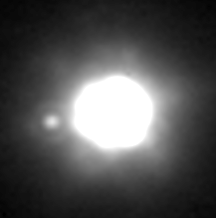Astronomy:762 Pulcova
 762 Pulcova and satellite as seen with adaptive optics in 2000[1] | |
| Discovery[2] | |
|---|---|
| Discovered by | G. N. Neujmin |
| Discovery date | 3 September 1913 |
| Designations | |
| (762) Pulcova | |
| Pronunciation | /ˈpʊlkəvə/ |
| Named after | Pulkovo Heights |
| 1913 SQ | |
| Minor planet category | Main belt |
| Adjectives | Pulcovian /pʊlˈkoʊviən/[3] |
| Orbital characteristics[2] | |
| Epoch 31 July 2016 (JD 2457600.5) | |
| Uncertainty parameter 0 | |
| Observation arc | 100.08 yr (36553 d) |
| |{{{apsis}}}|helion}} | 3.4801 astronomical unit|AU (520.62 Gm) (Q) |
| |{{{apsis}}}|helion}} | 2.8291 AU (423.23 Gm) (q) |
| 3.1546 AU (471.92 Gm) (a) | |
| Eccentricity | 0.10319 (e) |
| Orbital period | 5.60 yr (2046.5 d) |
| Mean anomaly | 348.62° (M) |
| Mean motion | 0° 10m 33.276s / day (n) |
| Inclination | 13.089° (i) |
| Longitude of ascending node | 305.76° (Ω) |
| 189.54° (ω) | |
| Known satellites | S/2000 (762) 1[1] |
| Earth MOID | 1.84297 AU (275.704 Gm) |
| Jupiter MOID | 1.60162 AU (239.599 Gm) |
| TJupiter | 3.158 |
| Physical characteristics | |
| Mean radius | 68.54±1.6 km |
| Mass | 1.40×1018 kg[4] |
| Mean density | 0.90 g/cm3[4] |
| Rotation period | 5.839 h (0.2433 d) |
| Sidereal rotation period | 5.839 hr[2] |
| Geometric albedo | 0.0458±0.002[2] |
| Apparent magnitude | 11.93 to 14.79[5] |
| Absolute magnitude (H) | 8.28[2] |
762 Pulcova is a main-belt asteroid. It was discovered by Grigoriy N. Neujmin in 1913,[2] and is named after Pulkovo Observatory, near Saint Petersburg. Pulcova is 137 km in diameter,[2] and is a C-type asteroid, which means that it is dark in colouring with a carbonate composition.
Photometric observations of this asteroid from Leura, Australia during 2006 gave a light curve with a period of 5.8403 ± 0.0005 hours and a brightness variation of 0.20 ± 0.02 in magnitude. This result is in agreement with previous studies.[6]
Satellite

On February 22, 2000,[1] astronomers at the Canada-France-Hawaii Telescope on Mauna Kea, Hawaii, discovered a 15-km moon (roughly a tenth the size of the primary)[7] orbiting Pulcova at a distance of 800 km.[8] Its orbital period is 4 days.[9] The satellite is about 4 magnitudes fainter than the primary.[8] It was one of the first asteroid moons to be identified.
Density
In the year 2000, Merline estimated Pulcova to have a density of 1.8 g/cm3, which would make it more dense than the trinary asteroid 45 Eugenia, and binary 90 Antiope.[8] But estimates by Marchis in 2008 suggest a density of only 0.90 g/cm3,[4] suggesting it may be a loosely packed rubble pile, not a monolithic object.
References
- ↑ Jump up to: 1.0 1.1 1.2 "762 Pulcova". SwRI. 2000-02-22. http://www.boulder.swri.edu/merline/press/fig3.html. (AO image)
- ↑ Jump up to: 2.0 2.1 2.2 2.3 2.4 2.5 2.6 "JPL Small-Body Database Browser: 762 Pulcova (1913 SQ)". https://ssd.jpl.nasa.gov/sbdb.cgi?sstr=762.
- ↑ Catalogue of the Mathematical, Historical, Bibliographical and Miscellaneous Portion of the Celebrated Library of M. Guglielmo Libri, 1861, p. 216
- ↑ Jump up to: 4.0 4.1 4.2 Jim Baer (2008). "Recent Asteroid Mass Determinations". Personal Website. http://home.earthlink.net/~jimbaer1/astmass.txt.
- ↑ Magnitudes generated with JPL Horizons for the year 1950 through 2100
- ↑ Oey, Julian (December 2006), "Lightcurves analysis of 10 asteroids from Leura Observatory", The Minor Planet Bulletin 33 (4): 96–99, Bibcode: 2006MPBu...33...96O.
- ↑ Dr. William J. Merline; Maria Martinez (2000-10-26). "Astronomers Image Double Asteroid". SwRI Press Release. http://www.boulder.swri.edu/merline/press/release.txt. (mentions both 90 Antiope and 762 Pulcova)
- ↑ Jump up to: 8.0 8.1 8.2 W.J. Merline (SwRI); L.M. Close (ESO, U. Arizona) (2000-06-21). "Discovery of Companions to Asteroids 762 Pulcova and 90 Antiope by Direct Imaging". SwRI. http://www.boulder.swri.edu/merline/press/dps.abstract.pdf.
- ↑ Johnston, Robert (September 1, 2005). "(762) Pulcova". Johnston's Archive. http://www.johnstonsarchive.net/astro/astmoons/am-00762.html.
External links
- Asteroids with Satellites, Robert Johnston, johnstonsarchive.net
- 762 Pulcova at AstDyS-2, Asteroids—Dynamic Site
- 762 Pulcova at the JPL Small-Body Database
 |


